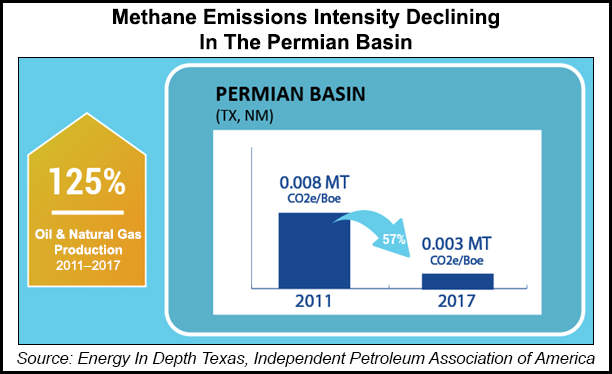Shale Daily | NGI All News Access | Permian Basin | Regulatory
Federal Data Shows 57% Drop in Permian Methane Emissions
Methane emissions in the Permian Basin declined 57% over a recent six-year period, according to federal government sources cited Friday by the New Mexico Oil and Gas Association (NMOGA).

Oil and natural gas production in the Permian, which straddles New Mexico and Texas, increased by 125% over the same time frame, NMOGA said.
New Mexico Gov. Michelle Lujan Grisham has made reducing methane emissions part of her vision to turn the state into a model for clean energy advancement.
According to data from the Environmental Protection Agency (EPA) and the Energy Information Administration (EIA), Permian methane emissions dropped to 4.6 million metric tons (mmt) of carbon dioxide-equivalent in 2017, down from 4.8 million mmt in 2011. During the same time frame, annual production in the basin jumped to 1.4 billion boe, up from 638.9 million boe.
The statistics come from EPA’s national greenhouse gas reporting program, which drew data from 8,000 oil and gas facilities nationwide. Production data and ranking came from EIA.
NMOGA Executive Director Ryan Flynn said the data shows Permian producers are “clearly making demonstrable progress” in managing methane emissions. “Advanced technology and new infrastructure have allowed the environmental footprint-per-unit of production to shrink even as production has dramatically expanded.”
Flynn said capturing methane from operations is a priority for New Mexico producers. “Despite the repeated distortions offered by extreme activists, producers are proving that it is possible to increase production and reduce emissions at the same time,” he said.
Under Lujan Grisham, New Mexico’s goal is to have the state’s utilities switch to 100% carbon-free energy use in the coming decades. The policy comes at a time when the Permian’s resurgence has pushed it ahead of California and Alaska as the leading oil producer.
In an executive order issued earlier this year, Lujan Grisham set in motion a war on methane, directing the state’s new climate change panel to come up with a “statewide, enforceable” regulatory framework.
Federal researchers have in the past pegged New Mexico as a major source of methane emissions. Lujan Grisham estimates at least half of the emissions can be contained by “proven, cost-effective and innovative technologies,” along with better industry practices.
© 2024 Natural Gas Intelligence. All rights reserved.
ISSN © 2577-9877 | ISSN © 2158-8023 |
